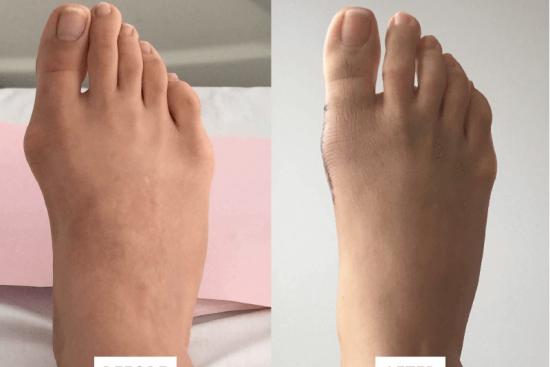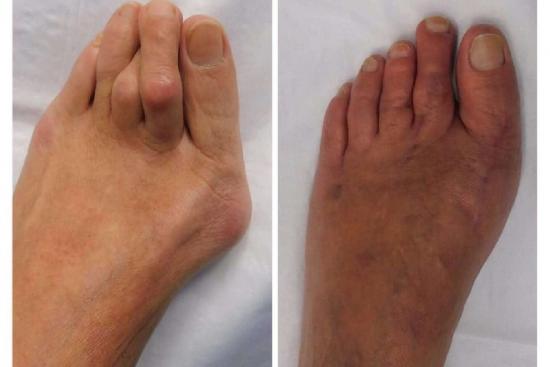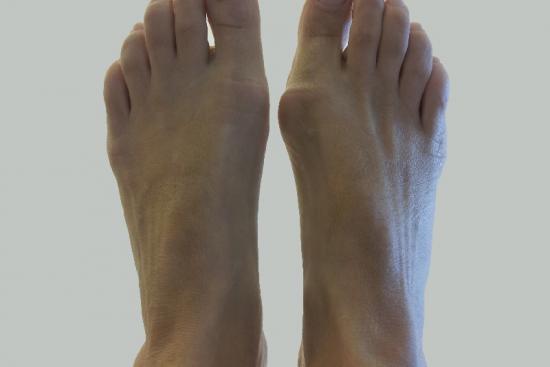Hallux valgus surgery is a procedure to correct the deformity characterized by the outward deviation of the big toe, and the formation of a bony protrusion, commonly known as a "bunion".
This deformity can also lead to the formation of hammertoes, where the second and third toes have bent phalanges and painful dorsal calluses.
We're Here to Help.
- People with bone deformity in the toes
- Bad bone position
- Osteoarthritis
- Tingling at the foot
- Pains
- Scars
- The operation lasts about half an hour
- The dressing should be kept for ten days
- Total convalescence 1 month after surgery
- 98%
When should we have hallux valgus surgery?
Hallux valgus is often a hereditary condition, and it's not uncommon for several members of the same family to suffer from it. This deformity tends to get worse over time and should only be operated on when it has become severe and is causing you acute discomfort and pain.
Hallux valgus affects women much more than men for reasons related to the type of footwear used and the hormonal structure of women versus men.
This deformity is mainly caused by improper footwear or prolonged wearing of high heels. Flat feet and advancing age are also risk factors for developing a bunion. In young patients, surgery can only be considered at the end of the growth phase, i.e. after the age of 16.
Hallux valgus surgery techniques
Hallux valgus surgery can be performed using a variety of techniques, depending on the surgical needs of the patient.
Minimally invasive techniques are currently the preferred choice, as they allow the pathology to be treated without the need for large incisions, thanks to the creation of small holes.
Minimally invasive percutaneous surgery
Minimally invasive percutaneous surgery to correct hallux valgus is performed under local anesthesia on an outpatient basis. The procedure, which lasts about 15 minutes, uses very fine instruments, which means no surrounding bone or tissue is exposed. No incisions are made; instead, tiny 2 to 5-mm diameter holes are made through which the orthopedic surgeon makes the correction.
During surgery, the surgeon uses a special X-ray machine (fluoroscope) to visualize the bones and instruments. This device allows the surgeon to be precisely guided in real-time. Surgical movements are similar to open techniques.
Percutaneous surgery is generally indicated for the correction of mild to moderate hallux valgus. For more severe and advanced deformities, screws may be inserted percutaneously through millimeter holes.
Open surgery technique
Open surgery for hallux valgus involves making an incision to expose the joint to be treated. The orthopedic surgeon then removes the protruding bone (osteotomy),followed by repositioning and fixation with synthetic means (such as screws and rods).
Although effective in resolving the condition, the open technique has been used less and less over time due to the capabilities of minimally invasive surgery.
Postoperative complications
As with any surgical procedure, certain complications can occur after hallux valgus surgery, sometimes requiring additional surgery.
Possible risks associated with surgery include
- Infection from screws or pins used during surgery.
- Poor bone position due to a loose osteotomy.
- Possible development of osteoarthritis.
- Tingling in the foot.
- Vascularization problems.
- Obvious scarring.
Recovery from bunion surgery
Postoperative recovery from hallux valgus surgery, regardless of the technique used, generally lasts between 30 and 40 days. Recovery times are often shorter with minimally invasive percutaneous surgery.
In all cases, it is possible to walk without difficulty and crutches from the start, even if only for a few minutes. It is advisable to avoid standing for too long and to keep movement to a minimum.
Approximately 2–3 weeks after the surgery, a follow-up visit will be scheduled to remove the stitches and dressing. A medical shoe must be worn for about 35 days after the operation.
Bunion surgery cost in Turkey
Choosing to have your bunion surgery in the best clinics or hospitals in Istanbul, Antalya, Ankara, and Izmir, Turkey, means benefiting from high-quality services at very affordable prices. The price of hallux valgus surgery depends on the surgical technique used and the severity of the deformity.
To learn more about bunion surgery cost in Turkey, request a free quote from one of our top orthopedic surgeons.
Share this page
Among our doctors
Several factors can cause the big toe deviation, such as:
- Age
- Heredity
- Wearing uncomfortable shoes
It is generally recommended that hallux valgus surgery be performed at the age of 50.
No, several treatments are recommended to alleviate the pain caused by the toe deformity, but nothing can replace surgery to correct the bone position.
If hallux valgus is left untreated, the patient may suffer from various complications such as:
- Infection spread in the joint (arthritis)
- Bone infection (osteitis)
- Foot osteoarthritis
- Bursitis: bursa chronic inflammation
After a hallux valgus operation, you should:
- Avoid walking for more than 30 minutes
- Wear post-operative shoes for an average of 20 days
- Reduce the swelling by stretching the legs as often as possible















